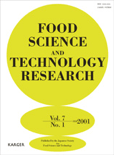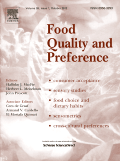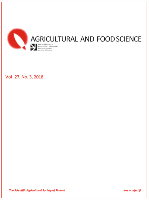
Journal of Insects as Food and Feed
Scope & Guideline
Connecting researchers to revolutionize food and feed.
Introduction
Aims and Scopes
- Sustainable Protein Sources:
The journal emphasizes the role of insects as alternative protein sources for both human consumption and animal feed, highlighting the environmental benefits of insect farming compared to traditional livestock. - Nutritional Analysis:
Research published in the journal often includes detailed nutritional profiling of various edible insect species, assessing their macro and micronutrient compositions, and their potential health benefits. - Food Technology and Processing:
The journal explores innovative processing methods for insect-based foods and feeds, including techniques for improving sensory attributes, digestibility, and safety of insect products. - Ecological Impact and Waste Valorization:
Studies frequently address the ecological implications of insect farming, including waste recycling and the use of by-products from food production as substrates for insect rearing. - Consumer Acceptance and Market Trends:
Research includes consumer attitudes towards insect consumption, market potential, and socio-economic factors influencing the adoption of insects in diets. - Animal Welfare and Farming Practices:
The journal promotes research on best practices in insect farming, focusing on welfare considerations and sustainable production methods.
Trending and Emerging
- Nutritional Enhancement of Insects:
Research focusing on enhancing the nutritional profiles of insects through dietary modifications and biofortification is gaining momentum, reflecting an increasing interest in maximizing the health benefits of insect consumption. - Insects in Aquaculture:
There is a rising trend in studies exploring the use of insects as feed in aquaculture, particularly concerning their role in improving the health and growth performance of aquatic species. - Innovative Food Products Incorporating Insects:
The development of new food products incorporating insects, such as snacks, protein powders, and baked goods, is on the rise, indicating a shift towards culinary innovation and mainstream acceptance. - Consumer Behavior and Acceptance Studies:
An increasing number of publications are focusing on consumer perceptions, willingness to pay, and market dynamics related to edible insects, reflecting the importance of understanding market trends for successful commercialization. - Environmental Sustainability Assessments:
Research assessing the environmental impacts of insect farming, including life cycle analyses and sustainability assessments, is becoming more prevalent, highlighting the ecological advantages of using insects as food and feed.
Declining or Waning
- Traditional Insect Farming Practices:
There is a noticeable decline in research focusing on traditional methods of insect farming, as the field shifts towards more sustainable and technologically advanced practices. - Basic Taxonomy of Edible Insects:
Research centered on the basic taxonomy of edible insects seems to be waning, likely due to a growing emphasis on applied research that addresses practical applications and sustainability rather than purely taxonomic studies. - Historical Consumption Patterns:
Studies on historical consumption patterns of insects are becoming less frequent, possibly overshadowed by a focus on contemporary practices and consumer acceptance in modern markets.
Similar Journals

FOOD SCIENCE AND TECHNOLOGY RESEARCH
Transforming Food Technology Through ScienceFOOD SCIENCE AND TECHNOLOGY RESEARCH, published by the Japanese Society of Food Science & Technology, is a pivotal journal that encompasses a wide spectrum of research in the fields of food science, biotechnology, and engineering. With its ISSN number 1344-6606 and a digital counterpart E-ISSN 1881-3984, this journal aims to disseminate cutting-edge research and innovative technologies that enhance food safety, quality, and sustainability. Recognized for its contributions, it holds a Q3 category ranking in multiple disciplines, including Food Science and Biotechnology, indicating a significant role in advancing academic discourse. Researchers and professionals can benefit from its insights, as the journal covers an array of topics relevant to industrial applications, marketing strategies, and scientific advancements. Although not an open-access journal, it has a wide reach and is committed to providing high-quality, peer-reviewed content essential for scholars and practitioners in the food science community from 1999 to 2024.

CANADIAN JOURNAL OF ANIMAL SCIENCE
Innovating Insights in Animal Science and Veterinary StudiesCanadian Journal of Animal Science, published by Canadian Science Publishing, stands as a pivotal platform in the fields of Animal Science and Zoology, reflecting its commitment to advancing knowledge and research in these crucial areas. Operating since 1975, with dedicated publication since 1993, this journal boasts an impactful history and has established itself within the academic community, holding a 2023 Q2 category rank in Animal Science and Zoology, and a Q3 rank in Food Animals. With its ISSN 0008-3984 and E-ISSN 1918-1825, the journal is accessible to a wide audience, promoting collaboration and the dissemination of innovation across borders. Although not an open-access journal, its valuable insights and research findings serve as essential resources for researchers, professionals, and students striving to enhance their understanding of animal science, veterinary studies, and agricultural practices. As the field of animal science continues to evolve, the Canadian Journal of Animal Science remains a vibrant and influential part of this dynamic landscape.

JOURNAL OF THE WORLD AQUACULTURE SOCIETY
Pioneering Research for Global Aquatic SolutionsThe JOURNAL OF THE WORLD AQUACULTURE SOCIETY, published by WILEY, serves as a premier platform for researchers, practitioners, and academics in the thriving fields of aquaculture and aquatic sciences. With an ISSN of 0893-8849 and an E-ISSN of 1749-7345, this esteemed journal boasts an impressive ranking in Scopus, placing it in the Q1 quartile for both Agronomy and Crop Science and Aquatic Science. Recognized for its rigorous peer-review process and high-quality publications since its inception in 1986, the journal continues to play a vital role in disseminating cutting-edge research that addresses the complex challenges and opportunities within aquaculture practices globally. The journal's impact is underscored by its rank of #37 out of 247 within the category of Aquatic Science and #70 out of 406 in Agronomy in 2023, positioning it firmly in the top tier of scholarly journals. Researchers and professionals will find an invaluable resource in this journal, which not only aims to advance scientific knowledge but also fosters a community committed to sustainable aquatic development.

Food Quality and Preference
Uncovering the Science Behind Food ChoicesFood Quality and Preference is a leading journal in the fields of food science and nutrition, published by ELSEVIER SCI LTD. With a notable impact factor and ranking in the Q1 quartile for both food science and nutrition and dietetics in 2023, this journal consistently publishes high-quality research that explores the multifaceted aspects of food preferences, sensory evaluation, and consumer behavior. The journal provides a critical platform for researchers, professionals, and students engaged in the study of food quality, aiming to enhance our understanding of how sensory properties, nutritional value, and consumer choices intersect. Its commitment to disseminating cutting-edge findings makes it an essential resource for advancing the field and informing practice in both academic and industry settings. Access to the journal is via subscription, allowing for robust engagement with pioneering research that shapes current and future practices in food-related studies.

AGRICULTURAL AND FOOD SCIENCE
Exploring the intersection of agriculture and technology.AGRICULTURAL AND FOOD SCIENCE is a prestigious journal published by the SCIENTIFIC AGRICULTURAL SOCIETY OF FINLAND, dedicated to advancing knowledge in the fields of agricultural and food sciences. With an ISSN of 1459-6067 and E-ISSN of 1795-1895, this open-access journal has been providing valuable insights and research findings since its inception in 2002. As of 2023, it holds a Q3 ranking in Food Science and is positioned at the 46th percentile within its Scopus category, ranking 210 out of 389 journals in Agricultural and Biological Sciences – Food Science. The journal features contributions from a global network of researchers, covering various topics including sustainable agricultural practices, food safety, and innovative food technologies. Based in Finland, the journal serves as an essential platform for scholars, professionals, and students who are committed to enhancing food security and agricultural productivity through rigorous scientific research. The convergence of interdisciplinary studies from 2004 to 2024 marks a critical evolution in the scope of agricultural and food research, making this journal a vital resource for anyone involved in these dynamic fields.

Carpathian Journal of Food Science and Technology
Pioneering Research in the Heart of Romania's Food ScienceCarpathian Journal of Food Science and Technology, a distinguished publication from the NORTH UNIV CENTER BAIA MARE, has been a pivotal platform for disseminating groundbreaking research in the field of food science since its inception in 2009. With an ISSN of 2066-6845 and an E-ISSN of 2344-5459, this Open Access journal aims to promote knowledge and innovation, offering unrestricted access to its content, thereby enhancing visibility for authors and facilitating a wider readership. Based in Romania, the journal plays a crucial role in advancing scientific inquiry within the agricultural and biological sciences, particularly focusing on contemporary food science issues. As it continues its convergence through 2024, the journal currently holds a Q4 ranking in the Food Science category, allowing it to carve out a unique niche within the academic community despite its current Scopus percentile ranking of 19th. Scholars, researchers, and students in the field will find the journal an invaluable resource for the latest advancements and discussions, making it an essential addition to their academic pursuits.

FLEISCHWIRTSCHAFT
Advancing meat science for a sustainable future.FLEISCHWIRTSCHAFT is a prominent academic journal published by Deutscher Fachverlag GmbH, dedicated to the field of food science, with a special focus on the meat industry. Established in Germany and boasting an ISSN of 0015-363X, this journal provides invaluable insights into meat production, processing, and quality assurance. Although it operates on a standard subscription basis, its contributions are essential for researchers, professionals, and students who seek to advance their knowledge in food safety, technology, and industry trends. With its historical convergence years spanning from 1973 to 2022, FLEISCHWIRTSCHAFT presents a rich repository of research that caters to current and evolving challenges within the agricultural and biological sciences. Classified in the Q4 quartile for Food Science, this journal plays a critical role in disseminating important findings and fostering scholarly dialogue within a niche but crucial sector of food science.

Annual Review of Food Science and Technology
Pioneering the Future of Food ScienceThe Annual Review of Food Science and Technology, published by ANNUAL REVIEWS, is an esteemed journal dedicated to advancing the knowledge within the field of food science. With an impressive Q1 ranking in the Food Science category, and ranking as #6 out of 389 in the Scopus Agricultural and Biological Sciences category, the journal serves as a vital resource for researchers, professionals, and students. This publication encapsulates comprehensive reviews and cutting-edge research, helping to bridge the gap between research and practical application. Though it does not offer Open Access, it provides valuable insights into various aspects of food science from 2010 to 2024, ensuring that its readership stays at the forefront of emerging trends and innovations. The journal's focus on high-quality, peer-reviewed articles makes it a critical platform for scholars looking to deepen their understanding and contribute to this rapidly evolving field.

Applied Animal Science
Elevating Standards in Animal Science ResearchApplied Animal Science, published by Elsevier Science Inc, is an esteemed journal that has quickly made its mark in the fields of Animal Science and Food Science since its inception in 2019. With an ISSN of 2590-2873 and an E-ISSN of 2590-2865, this journal has received commendable recognition, achieving a Q2 ranking in both categories as of 2023. Encompassing a broad scope that integrates cutting-edge research and practical applications, Applied Animal Science seeks to disseminate knowledge that advances the well-being of animal systems and food safety. Researchers and professionals in the agricultural and biological sciences benefit from its high-quality articles, which are ranked #152 out of 490 and #200 out of 389 in their respective fields according to Scopus rankings. While currently not open access, the journal remains accessible to a global audience of scholars eager to explore innovative findings and robust methodologies. As it continues to grow through 2024 and beyond, Applied Animal Science aims to be a pivotal platform for fostering knowledge exchange and inspiring future studies in its domain.

Animal Nutrition
Fostering a Healthier Future Through Nutritional InsightsAnimal Nutrition is a premier open-access journal dedicated to advancing the understanding of nutritional science in animals, published by KEAI PUBLISHING LTD. Established in 2015, this journal has quickly risen to prominence within its field, securing a Q1 ranking in both Animal Science and Zoology and Food Animals as of 2023. With an impressive Scopus ranking, positioned first among 39 journals in Veterinary Food Animals and tenth among 490 in Agricultural and Biological Sciences - Animal Science and Zoology, it remains a critical resource for researchers, professionals, and students alike. The journal's commitment to open access ensures that cutting-edge research is readily available to a global audience, fostering the dissemination of knowledge that drives innovation in animal nutrition and health. With a focus on the intersection of animal physiology, dietary interventions, and food production systems, Animal Nutrition plays a pivotal role in shaping sustainable practices and improving animal welfare worldwide.